Table of Contents
ToggleRenovating an old house? Talk about an adventure. It’s like unearthing buried treasure, only the treasure might sometimes look more like a leaky roof and plaster dust than gold coins. But fear not – with the right knowledge, a bit of grit, and more than a few cups of coffee, transforming that shabby chic into a masterpiece is absolutely within reach. This guide balances humor and professionalism to help navigate the ups and downs of old house renovations, ensuring your project is as rewarding as it is challenging.
Understanding the Challenges of Old House Renovation

Renovating an old house presents unique challenges that can easily lead to a few gray hairs if not properly managed. First, an assessment of the home’s condition is crucial.
Assessing the Condition of Your Home
Are those creaking floorboards a sign of charm or impending disaster? An honest assessment helps determine the true state of your home. Jump into the attic, peer into the crawl space, and inspect the walls. Look for signs of moisture, mold, or structural issues that could require costly repairs later. Fresh paint might cover a multitude of sins, but a thorough inspection will save heartache down the line.
Common Issues in Old Houses
Old houses bring a mixed bag of surprises. You may find outdated electrical systems, uneven floors, or even charming but drafty windows. Plumbing might resemble a game of Twister. Understanding these common issues can help streamline renovations and prevent unpleasant surprises. Knowledge here is power: being aware of potential problems turns renovation woes into manageable tasks.
The Importance of Building Codes and Permits
Ever tried to navigate a minefield? That’s what diving into building codes and permits can feel like. But, they are non-negotiable aspects of any house renovation. Each town may have specific regulations about historic preservation and safety standards. Not only do these codes keep you safe, they also protect the value of your property. Failing to follow them might seem like a shortcut but could lead to fines or worse – having to redo work that’s already been completed. So, before the sledgehammer swings, check with local authorities and ensure all necessary permits are in place.
Planning Your Renovation Project
Planning is the backbone of a successful renovation. Without a solid foundation for your plans, things can spiral quickly.
Budgeting for Your Renovation
First off, let’s talk about budgeting. It’s vital to create a realistic budget that accounts for both expected and unexpected costs. Experts often recommend setting aside at least 10-20% of your budget for those ‘surprise.’ expenses that tend to emerge in old homes. The last thing anyone wants is to feel like their hopes for a cozy kitchen fell apart like an old wall.
Selecting the Right Professionals
Once the plans are set, the next step is assembling a team of professionals. This stage is just as critical as the planning phase: having the right team can either make or break a renovation project.
Preserving Historical Features
Select contractors who understand the importance of historical features. These experts will know which elements can be restored and which should be replaced. Consider specialists in historical preservation to ensure that the charisma of your old house carries through the renovations. If keeping that ornate crown molding is paramount, it’s worth the investment.
Modernizing for Efficiency While Keeping Charm
At the same time, there’s the need for modern efficiency. Your house may need new systems to keep up with energy standards, all while maintaining that vintage charm. Finding a balance is key. There are plenty of strategies available, from energy-efficient windows to updated insulation, that can preserve the aesthetics without sacrificing functionality.
What to Do During the Renovation Process
As the renovations begin, preparation for the process is essential. Living through renovations isn’t grand, and sometimes it feels more like camping than comfortable living.
Safety Considerations
Safety should always come first. Old houses can hide dangers like lead paint or asbestos. Before swinging the hammer, ensure the area is safe. Create a demolition plan that minimizes risks and involves proper safety gear. You’ll thank yourself later, especially when the dust clears.
Living Arrangements During Renovation
During the renovation itself, it might be wise to consider alternative living arrangements, especially for significant projects. Family and friends can offer a temporary couch, or consider renting nearby. Living in a home under construction can be noisy and messy, making it challenging to maintain a sense of peace.







